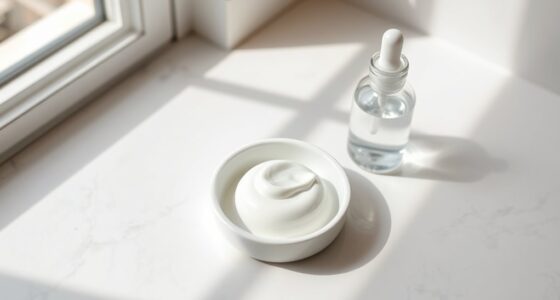Cellulite creams often promise quick, dramatic results, but most of their benefits are temporary. They contain ingredients like caffeine, retinol, and peptides that may tighten skin or boost circulation briefly but don’t provide lasting solutions. These products mainly improve water retention or create a temporary plumping effect—nothing that tackles the root causes. If you want to know what’s really behind these claims and what works best, keep exploring deeper truths about cellulite treatments.
Key Takeaways
- Most cellulite creams provide only temporary skin tightening through hydration and water retention, not permanent fat reduction.
- Ingredients like caffeine and retinol may improve appearance briefly but lack strong scientific evidence for long-term cellulite elimination.
- Marketing claims often exaggerate results; real improvements require consistent use and realistic expectations.
- Water retention and inflammation influence cellulite appearance more than topical treatments alone.
- Long-lasting cellulite reduction typically involves lifestyle changes, such as diet, exercise, and professional procedures, not just creams.
How Cellulite Creams Claim to Work
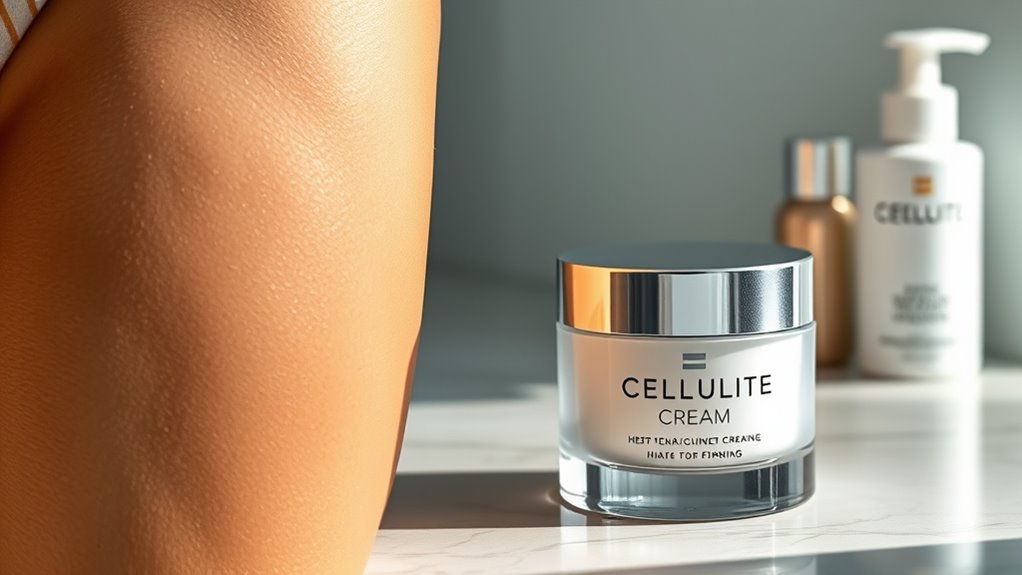
Cellulite creams claim to work by penetrating the skin to target the underlying fat and connective tissue. They promise to smooth and tighten the skin’s surface, reducing the appearance of dimples. Usually, these creams contain ingredients that are supposed to stimulate blood flow, boost collagen production, or improve lymphatic drainage. The idea is that these effects can break down fat deposits or tighten the skin, making cellulite less visible. When you apply the cream, it’s intended to absorb quickly into your skin, reaching the layers beneath. The manufacturers suggest consistent use will lead to noticeable improvements over time. While this sounds promising, understanding how these claims are made is key to evaluating whether they’re realistic or just marketing hype. Additionally, the effectiveness of these creams can be influenced by factors like the bedroom environment, which impacts overall skin health and appearance. Factors such as hydration, sleep quality, and overall lifestyle play a role in skin condition and enhancement. Moreover, some ingredients in these creams may not have strong scientific backing, highlighting the importance of examining ingredient lists critically for evidence-based results. Furthermore, the presence of placebo effects can sometimes lead users to believe they see improvements even when the product has little to no active impact. Recognizing the role of mind-body connection can help set realistic expectations about the results.
The Actual Ingredients in Most Cellulite Products
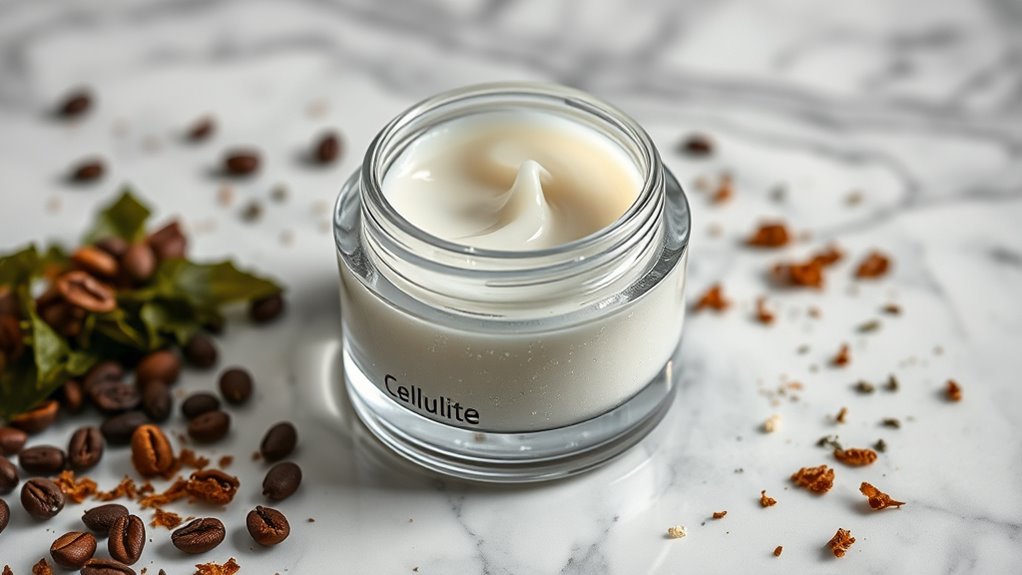
Most cellulite products contain a mix of active ingredients that claim to tighten skin and reduce the appearance of dimples. You’ll find common components like caffeine, retinol, and peptides, each with their own supposed benefits. Understanding these ingredients helps you make smarter choices about what might actually work. Additionally, some formulations incorporate natural extracts like green tea or coffee, which are believed to have fat-burning properties that could enhance their effectiveness. However, it’s important to note that the efficacy of these ingredients varies, and clinical studies often show mixed results. To maximize potential benefits, many formulations also include hydrating agents, which can improve skin elasticity and appearance. Exploring ingredient transparency can help consumers better understand what they are applying to their skin. Embracing a growth mindset when evaluating these products can lead to more informed and realistic expectations.
Active Ingredients Breakdown
Many cellulite creams contain a blend of active ingredients designed to improve skin appearance and reduce the appearance of dimpling. Caffeine is a common component, as it temporarily tightens skin and boosts circulation, giving a smoother look. Centella Asiatica extract is often included to stimulate collagen production and improve elasticity. Retinol helps increase cell turnover and thickens the skin, reducing the visibility of cellulite. Some formulas feature peptides, which may support skin firmness and structure over time. Additionally, antioxidants like vitamin C can brighten skin and protect against damage. While these ingredients target various factors contributing to cellulite, their effectiveness varies, and results often depend on consistent use and individual skin response. Incorporating ingredients that promote skin elasticity can enhance overall results and support healthier skin. Regular use of ingredients that boost collagen and improve cellular turnover may lead to more noticeable improvements over time. To maximize benefits, some formulations also include natural extracts with anti-inflammatory properties to soothe the skin and reduce irritation. The presence of hydrating agents can also help maintain skin suppleness and reduce the appearance of dimples. Moreover, ensuring proper product formulation can significantly influence the efficacy of cellulite creams.
Commonly Used Components
You’ll often find a variety of active ingredients in cellulite creams, each targeting specific issues like skin firmness, elasticity, and appearance. These components are chosen for their supposed ability to improve skin texture and reduce the dimpled look.
- Caffeine – Known for its ability to temporarily tighten skin and boost circulation, making cellulite less noticeable.
- Retinol – Promotes collagen production, which can improve skin firmness over time.
- L-Carnitine – Believed to help break down fat cells and improve skin smoothness.
While these ingredients are common, their actual effectiveness varies. Many work temporarily or require consistent use, but they rarely deliver dramatic or permanent results.
Do These Creams Provide Long-Term Results?

While some cellulite creams claim to offer long-lasting results, evidence shows that their effects are often temporary. Most creams work by tightening the skin or reducing water retention, which can create a smoother appearance initially. However, these improvements usually fade once you stop using the product. The active ingredients rarely target the root causes of cellulite, like fat deposits or connective tissue weakness. Without ongoing use, your skin quickly returns to its previous state. Long-term results require consistent maintenance and lifestyle changes, such as regular exercise and a healthy diet. Cellulite creams alone, especially those that only temporarily plump or tighten the skin, rarely provide lasting benefits. Additionally, advances in generative AI in media and entertainment are transforming how content is created and consumed, but such innovations do not influence the temporary effects of topical skincare products. To achieve sustained improvement, integrating lifestyle modifications is essential, as topical treatments alone are insufficient for long-term change.
The Role of Water Retention and Temporary Effects
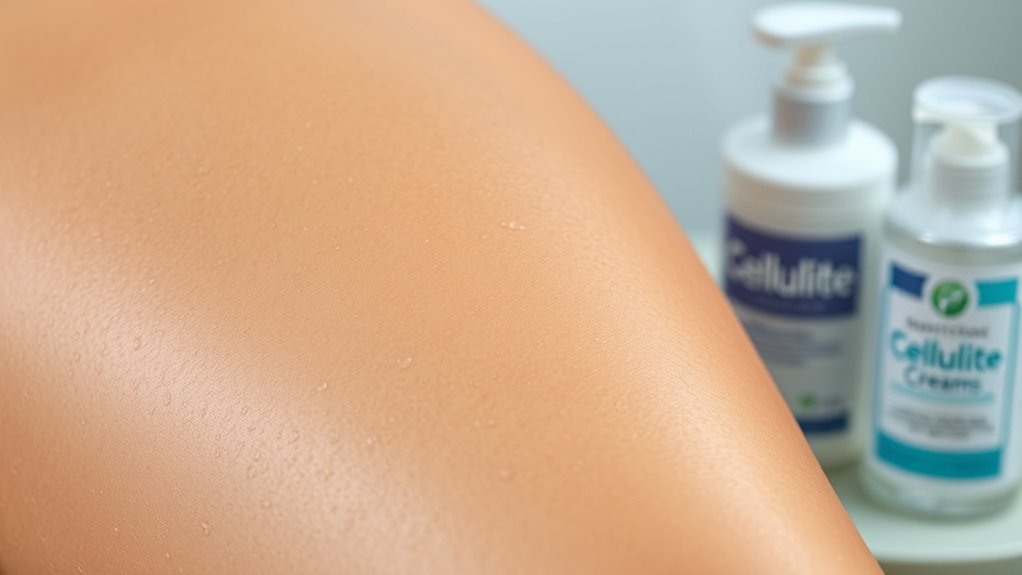
Water retention can temporarily make your skin look smoother and tighter, but it’s often caused by factors like salt intake or hormonal changes. When a cream hydrates your skin, it can give a plumping effect that masks cellulite for a short time. Keep in mind, this effect isn’t permanent and doesn’t address the root causes. Additionally, some ingredients in skincare products may influence water retention and the appearance of your skin. Recognizing the role of aquatic exercise and water-based therapies can help you understand the deeper emotional aspects behind body image concerns and confidence. Understanding market trends and how products are marketed can also shed light on the temporary nature of these treatments. Exploring environmental impacts associated with cosmetic ingredients can provide a more comprehensive view of the broader implications of skincare choices.
Water Retention Causes
Water retention often causes temporary swelling and puffiness in the skin, making cellulite appear more pronounced. This happens when your body holds onto excess fluids, which can be triggered by factors like high salt intake, hormonal changes, or dehydration. Understanding these causes helps you see why cellulite may look worse at certain times. Additionally, consuming fresh pineapple juice can help reduce inflammation and water retention due to bromelain’s anti-inflammatory properties. Recognizing fluid balance can also influence how you manage your health and finances during this time, especially as maintaining proper hydration supports both physical well-being and overall lifestyle balance. Being aware of market trends can help you better understand the fluctuating appearance of cellulite and manage expectations accordingly.
Temporary Skin Tightening
Temporary skin tightening occurs when water retention causes your skin to appear firmer and more lifted, but this effect isn’t permanent. When your body retains extra water, it can fill in dimples and smooth out surface irregularities, making cellulite less noticeable temporarily. Many creams contain ingredients that boost blood flow or create a tightening sensation, giving an immediate but short-lived improvement. However, this effect relies solely on water retention and skin surface tension, not on actual fat reduction or collagen rebuilding. Once your body’s water levels normalize, the skin returns to its previous state, revealing the true extent of cellulite. So, while you might see a quick change after applying certain products, these results are only temporary and don’t address the underlying causes.
Hydration and Plumping
Have you ever noticed how some creams instantly make your skin feel firmer or smoother? That’s often due to hydration and plumping ingredients that temporarily boost water retention. These creams work quickly by filling in fine lines and smoothing surface irregularities.
- They attract water into the skin, giving a plump, fuller appearance.
- Ingredients like hyaluronic acid or glycerin draw moisture from deeper layers, making your skin look more youthful.
- The effects fade as the water evaporates or absorption slows, so the plumpness is temporary.
While hydration can improve skin texture briefly, it doesn’t eliminate cellulite or address underlying issues. It’s a quick fix, but not a long-term solution.
Scientific Evidence Supporting Cellulite Creams

Is there solid scientific proof that cellulite creams work? The truth is, research supporting their effectiveness is limited. Some creams contain ingredients like caffeine, retinol, or peptides, which may temporarily tighten the skin or improve its appearance. A few small studies suggest that retinol can boost collagen production, potentially reducing the appearance of cellulite over time. However, these effects are usually modest and not guaranteed. Most scientific reviews conclude that while some ingredients show promise, the overall evidence isn’t strong enough to confirm significant, lasting results. Keep in mind, individual experiences vary, and the degree of improvement depends on factors like skin type and cellulite severity. So, don’t rely solely on creams for a dramatic transformation—expect only temporary or minimal changes.
Common Misleading Marketing Tactics
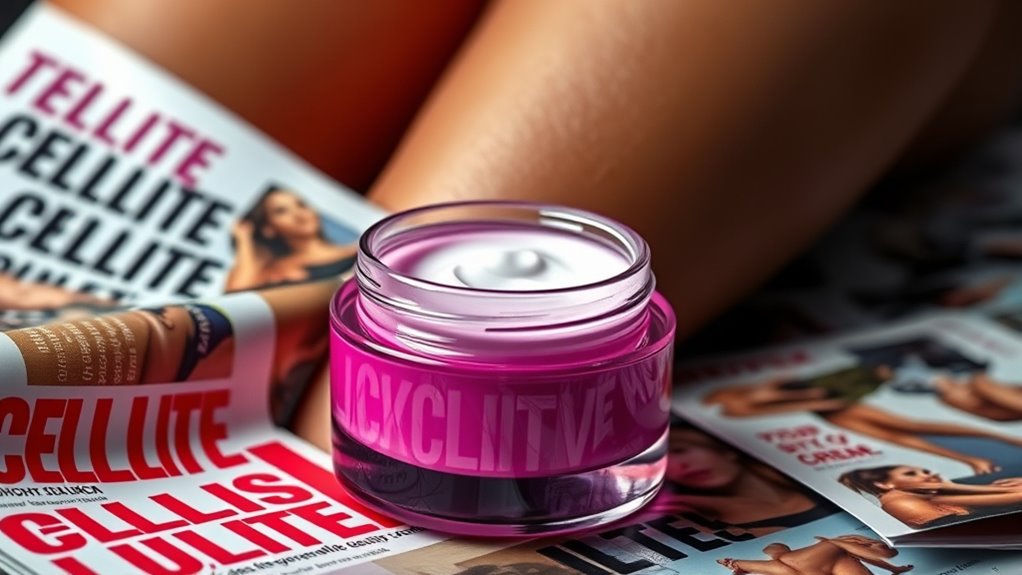
Many cellulite cream advertisements promise quick, dramatic results that often don’t materialize, but they can be quite convincing. They use tactics designed to catch your eye and create false hope.
- Before-and-after photos: These images are often heavily edited or staged, making the results appear more dramatic than what’s realistic.
- Bold claims with vague science: Phrases like “reduces cellulite in days” are common, even when scientific backing is weak or nonexistent.
- Celebrity endorsements: You may see famous faces endorsing products without disclosing they’re paid or that their results are not typical.
These tactics play on your desire for quick fixes, but they often oversimplify the reality of cellulite treatment.
Why Expectations Often Don’t Match Reality
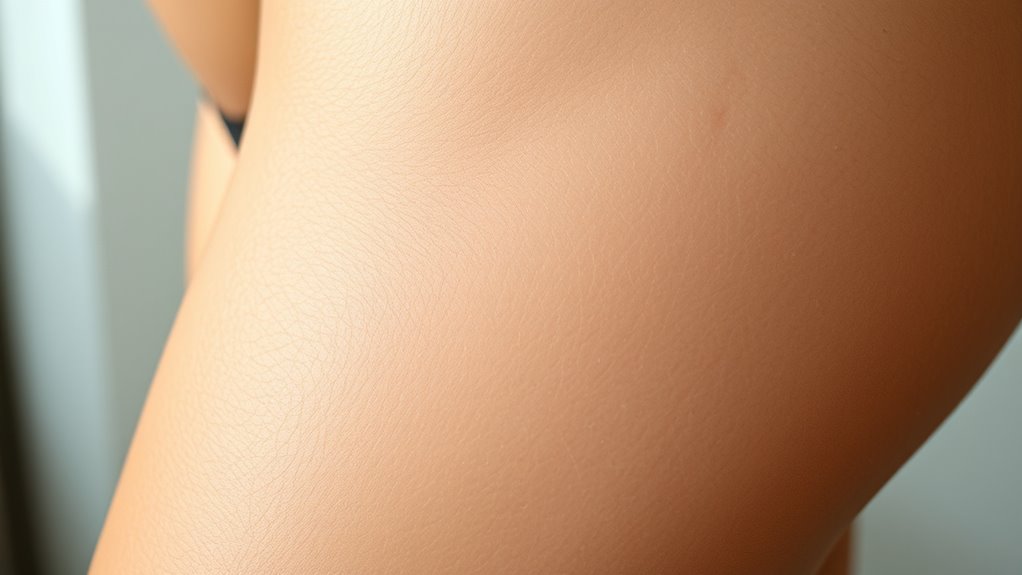
Despite the appealing promises made in advertisements, your expectations often don’t match reality because cellulite creams typically offer only modest improvements at best. These products might temporarily smooth the skin or reduce the appearance of dimpling, but they rarely eliminate cellulite entirely. The effects are usually subtle and short-lived, especially compared to the dramatic results shown in ads. Factors like genetics, skin structure, and lifestyle play significant roles that creams can’t change overnight. Many users find that their expectations of a quick fix lead to disappointment when results fall short. Remember, cellulite is a complex issue, and no cream can completely erase it. Managing realistic expectations helps you make better choices and avoid unnecessary frustration.
Cost vs. Benefit: Are They Worth It?
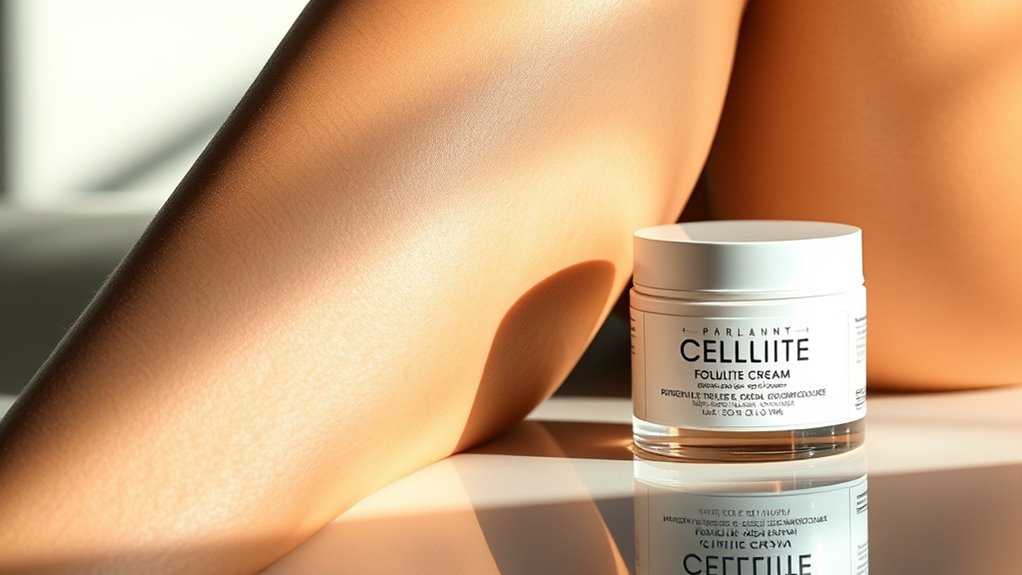
Cellulite creams often come with a hefty price tag, making it essential to weigh their costs against the benefits they provide. First, consider the financial investment—are you willing to spend on products that may offer only temporary results? Second, evaluate the time commitment—consistent application is necessary, but improvements can be subtle or short-lived. Third, think about your expectations—are you hoping for a dramatic transformation, or are minor improvements enough? While some creams may improve skin texture slightly, they rarely deliver lasting or significant results for the price. Ultimately, you need to decide if the potential benefits outweigh the costs, or if your money might be better spent exploring alternative methods.
Alternative Approaches to Reducing Cellulite
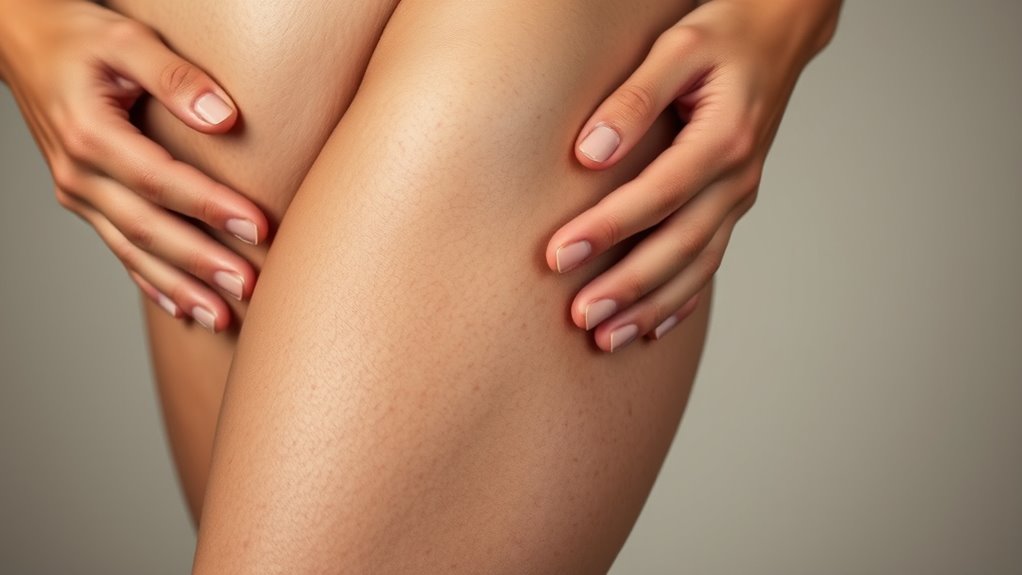
While cellulite creams can be tempting, exploring alternative methods might offer more sustainable results. Regular exercise, especially strength training and cardio, helps improve muscle tone and reduce fat, which can lessen the appearance of cellulite. Staying hydrated boosts skin elasticity, making cellulite less noticeable. Eating a balanced diet rich in fruits, vegetables, and lean proteins supports healthy skin and reduces inflammation. Dry brushing or massage techniques can temporarily improve circulation and smooth skin texture. Some people find that treatments like radiofrequency, laser therapy, or acoustic wave therapy provide more noticeable and lasting improvements. Keep in mind, these options often require consistent effort and may involve costs, but they target the underlying factors contributing to cellulite more effectively than topical creams alone.
What to Look for When Choosing a Firming Cream
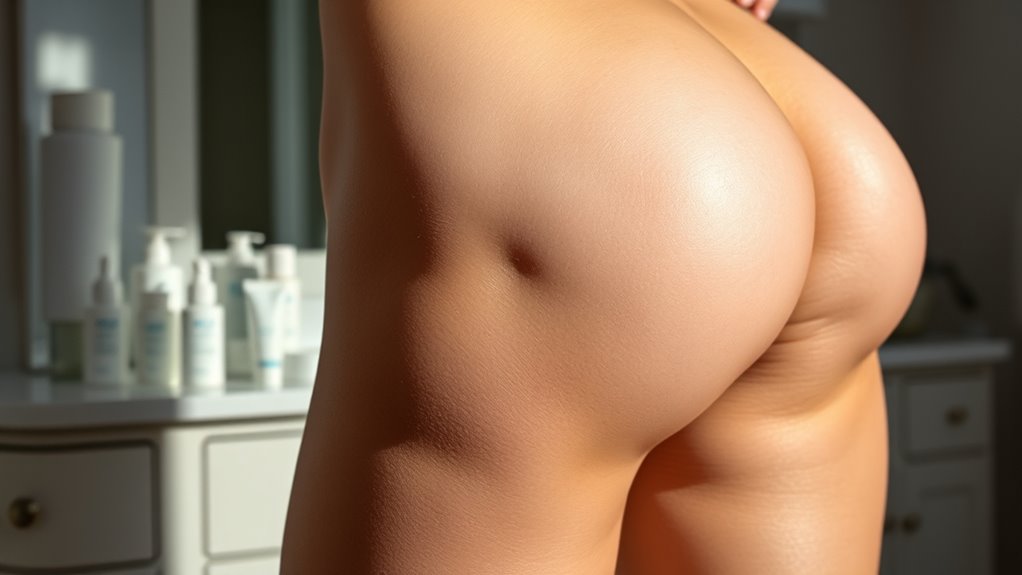
When choosing a firming cream, you should pay attention to key ingredients like caffeine or retinol that boost firmness. Look for products with proven effectiveness, supported by reviews or clinical trials. Also, make sure the cream is suitable for your skin type to avoid irritation and get the best results.
Key Ingredients to Seek
Choosing an effective firming cream means paying close attention to its key ingredients. Look for components scientifically proven to improve skin firmness and elasticity. First, caffeine helps stimulate circulation and temporarily tightens skin, giving a smoother appearance. Second, retinol promotes collagen production, strengthening skin structure over time. Third, peptides support cellular repair and boost collagen, enhancing skin firmness. These ingredients work together to improve the skin’s texture and combat the effects of cellulite. Avoid products filled with fillers or vague botanical extracts that lack proven benefits. Always read labels carefully to guarantee these key ingredients are present in effective concentrations. By focusing on these ingredients, you’re more likely to choose a cream that delivers visible, lasting results.
Proven Effectiveness Indicators
To determine if a firming cream will actually deliver results, look beyond the ingredient list and focus on proven effectiveness indicators. First, check for clinical studies or trials that support the product’s claims. Reputable brands often publish or reference independent research showing visible improvements in skin firmness or elasticity. Next, look for user testimonials and before-and-after photos, which can provide real-world evidence of effectiveness. Be cautious of products with vague or exaggerated promises; genuine creams typically specify how long results may take. Additionally, check if the product has received third-party endorsements or certifications. These indicators help guarantee you’re choosing a cream with verified results, rather than just marketing hype.
Skin Type Compatibility
Since skin type varies greatly, selecting a firming cream compatible with your specific skin needs is essential for best results. Knowing your skin type ensures you choose products that won’t cause irritation or reduce effectiveness.
To find the right fit, look for creams that specify suitability for your skin type.
- Sensitive Skin: Opt for fragrance-free, hypoallergenic formulas that soothe without irritation.
- Dry Skin: Choose hydrating creams with ingredients like hyaluronic acid or shea butter to boost moisture.
- Oily or Acne-Prone Skin: Select lightweight, non-comedogenic formulas that won’t clog pores or exacerbate oiliness.
Matching your skin type with the right product maximizes absorption, diminishes adverse reactions, and enhances your overall results.
Frequently Asked Questions
Are There Any Natural or Homemade Alternatives That Work Better?
You’re wondering if natural or homemade remedies can beat commercial cellulite creams. While some people find that regular dry brushing, coffee scrubs, or massage with essential oils help improve skin’s appearance, results vary. Staying hydrated, eating a balanced diet, and exercising regularly also support skin elasticity. Although these options might not eliminate cellulite entirely, they can enhance your skin’s overall look and boost your confidence naturally.
How Quickly Can I Expect Visible Results From Cellulite Creams?
You’re asking how fast cellulite creams show results. Keep in mind, these products aren’t magic potions; they work like a slow burn. Typically, you might see subtle changes in 4 to 6 weeks if you use them consistently. Don’t expect miracles overnight—patience is key. For the best results, combine creams with a healthy diet and regular exercise. Remember, persistence pays off!
Do These Creams Have Any Side Effects or Health Risks?
You wonder if cellulite creams cause side effects or health risks. While some products may contain ingredients that can cause skin irritation or allergic reactions, serious health issues are rare. Always read labels carefully, patch-test before full use, and consult a healthcare professional if you have sensitive skin or concerns. Remember, results vary, and safety should always come first when trying new skincare products.
Can Exercise or Diet Enhance the Effectiveness of These Creams?
Did you know that 80% of women report improvements in skin texture with combined treatments? Exercise and diet can definitely boost the effectiveness of cellulite creams. When you stay active and eat a balanced diet, you improve blood flow and reduce fat, making creams work better. So, pairing your skincare routine with healthy habits helps you see more noticeable results faster. Keep moving and eating well for the best outcome.
Are There Specific Skin Types That Respond Better to Cellulite Treatments?
You might notice some cellulite treatments work better on certain skin types. Typically, those with lighter or less textured skin see more visible results because the skin’s elasticity and thickness influence how treatments penetrate and respond. If you have darker, thicker, or more textured skin, you may need more intensive or combined approaches. Always consult a dermatologist to determine the best treatment plan tailored to your skin type and goals.
Conclusion
In the end, don’t rely solely on cellulite creams to transform your body into a flawless masterpiece. While they might offer fleeting improvements, true confidence comes from embracing your natural beauty and exploring proven, lasting solutions. Remember, no miracle potion can turn back the clock or erase years in a single swipe. Be smart, stay informed, and realize that your worth isn’t measured by dimples—you’re already stunning just as you are.





